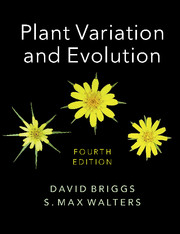Book contents
- Frontmatter
- Contents
- Preface to the Fourth Edition
- Acknowledgements
- Note on names of plants
- List of abbreviations
- 1 Investigating plant variation and evolution
- 2 From Ray to Darwin
- 3 Early work on biometry
- 4 Early work on the basis of individual variation
- 5 Post-Darwinian ideas about evolution
- 6 DNA: towards an understanding of heredity and molecular evolution
- 7 Breeding systems
- 8 Intraspecific variation and the ecotype concept
- 9 Pattern and process in plant populations
- 10 Pattern and process: factors interacting with natural selection
- 11 Populations: origins and extinctions
- 12 Species and speciation: concepts and models
- 13 Allopatric speciation and hybridisation
- 14 Abrupt speciation
- 15 The species concept
- 16 Flowering plant evolution: advances, challenges and prospects
- 17 Historical biogeography
- 18 The evolutionary impact of human activities
- 19 The taxonomic challenge ahead
- 20 Conservation: from protection to restoration and beyond
- Glossary
- References
- Index
18 - The evolutionary impact of human activities
Published online by Cambridge University Press: 05 June 2016
- Frontmatter
- Contents
- Preface to the Fourth Edition
- Acknowledgements
- Note on names of plants
- List of abbreviations
- 1 Investigating plant variation and evolution
- 2 From Ray to Darwin
- 3 Early work on biometry
- 4 Early work on the basis of individual variation
- 5 Post-Darwinian ideas about evolution
- 6 DNA: towards an understanding of heredity and molecular evolution
- 7 Breeding systems
- 8 Intraspecific variation and the ecotype concept
- 9 Pattern and process in plant populations
- 10 Pattern and process: factors interacting with natural selection
- 11 Populations: origins and extinctions
- 12 Species and speciation: concepts and models
- 13 Allopatric speciation and hybridisation
- 14 Abrupt speciation
- 15 The species concept
- 16 Flowering plant evolution: advances, challenges and prospects
- 17 Historical biogeography
- 18 The evolutionary impact of human activities
- 19 The taxonomic challenge ahead
- 20 Conservation: from protection to restoration and beyond
- Glossary
- References
- Index
Summary
This chapter examines the evolutionary influences of human activities, and considers the proposition that many species are threatened with extinction.
Humans: as animals practising extreme niche construction
Anatomically modern humans arose in Africa over 100 000 years ago, and by 40 000 years ago they were perhaps fully human in anatomy, behaviour and language (Diamond, 1992). Increasingly, as humans have migrated to almost all parts of the globe, they have influenced, modified, managed or transformed all the Earth's natural ecosystems by practising what has been termed ‘niche construction’.
Leland (2002) notes that, traditionally, ‘adaptation typically is regarded as a process by which natural selection molds organisms to fit a pre-established environmental template … yet in varying degrees, organisms choose their own habitats, choose and consume resources, generate detritus, construct important components of their own environments … destroy other components and construct environments for their offspring. Thus, organisms not only adapt to their environments but in part also construct them.’ In the case of humans, niche construction may be seen, therefore, as an evolutionary strategy that aims to maximise survival and reproductive success.
Human environmental activities through the development of cultural practices have many intentional effects. As Western (2001) observes, ‘the most universal and ancient features of our “humanscapes” arise from a conscious strategy to improve food supplies, provisions, safety, and comfort – or perhaps to create landscapes we prefer, given our savanna ancestry’. He points out, however, that there are many unintended side effects of human activities that lead to a multiplicity of consequences at every spatial scale, and his list includes: habitat and species loss; loss of keystone species; major changes to ecosystems resulting in reduced ecotones; truncated ecological gradients and changes to soils and accelerated erosion; introductions of invasive non-native species and diseases; side effects of fertilisers, pesticides, herbicides; over-harvesting of natural resources; nutrient leaching and eutrophication; pollution of soils, water and air; and ‘global changes to the lithosphere, hydrosphere, atmosphere and climate’.
Human impact on the environment
The formal geological term for the last 11 700 BP years is the ‘Holocene’, but human niche construction has become so universal and dominating that the present era has been called the ‘Anthropocene’ (Ruddiman, 2013). There has been a great deal of debate about when this era might have begun.
- Type
- Chapter
- Information
- Plant Variation and Evolution , pp. 411 - 438Publisher: Cambridge University PressPrint publication year: 2016

